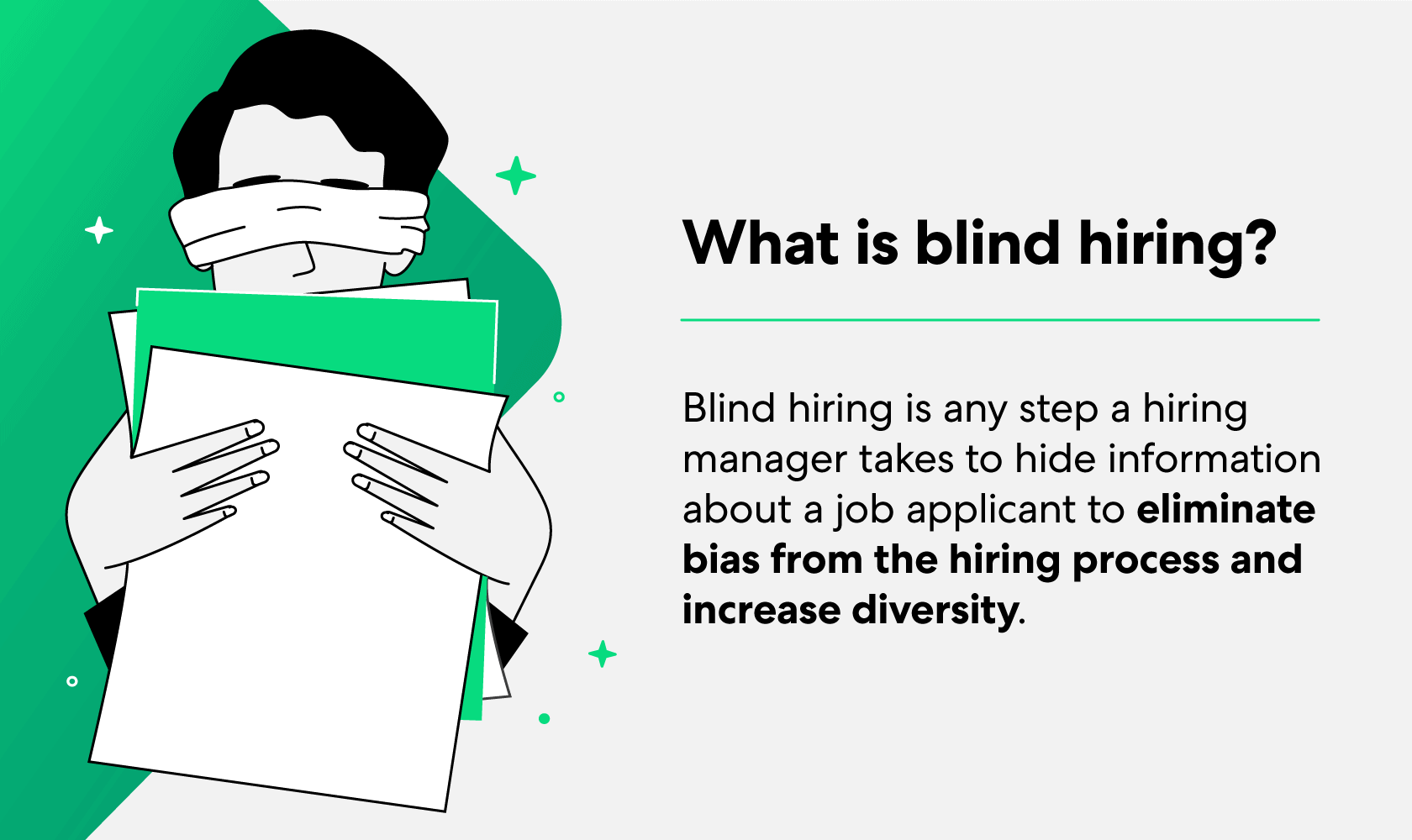When it comes to your business, it’s likely you’ve stayed away from making any type of “blind” decision. However, with a lack of diversity and representation among many businesses and corporate leadership, the case for blind hiring is becoming all the more important.1
A recent study done by Gallup found that gender-diverse businesses have better financial outcomes than those dominated by one gender.2 In order to protect the longevity of your business, honing your recruitment process doesn’t just mean vetting for the best applicants, but delivering with diversity as well.
So, what exactly is blind hiring? Read on or skip to our infographic to discover the pros and cons of the blind hiring process, and reasons why you may want to implement it for your small business.
What is blind hiring?

Blind hiring, or blind recruitment, is any step a hiring manager takes to hide information about a job applicant to eliminate bias from the hiring process. This could include the removal of a candidate’s name, address, location, or any other identifying factors from their application.
Common Hiring Biases
Hiring biases can impact your company’s engagement, culture, and even lower morale and productivity. In fact, studies show that diverse teams have improved productivity and results by 60% compared to non-diverse teams.3 There are two types of hiring biases: Primary and Secondary.
Primary bias includes bias against:
- Gender
- Age
- Physical ability
- Sexual orientation
- Ethnicity
- Race

The benefits of workplace diversity
Through eliminating conscious and unconscious hiring bias, businesses have a better chance of bringing in diverse people through the recruitment process. Blind hiring can help employers ignore any initial preconceived notions they may have about an applicant based on their education, name, gender, etc. Below are a few benefits of a more diverse workforce.
- Productivity: Diverse teams deliver 60% better results.4
- Employee engagement: 83% of millennials are more likely to be actively engaged if they believe their company stimulates a diverse and inclusive culture.5
- Increased revenue: Companies with high racial diversity see 15 times more revenue and sales.6
- New markets: Employees of firms with 2-D diversity are 70% likelier to report that the firm captured a new market.7

6 ways to implement blind hiring
There are a number of ways you can implement blind hiring into your recruitment process — from manually crossing out revealing information on a resume to using blind screening technology. Regardless of what practice you choose, all methods begin with educating your team members.
 1. Blind candidate screening: Online HR tools make it easy for recruiters and hiring managers to obscure personal information from a candidates application, resume or profile. For instance, Blendoor removes the names and photos of a candidate in order to promote diversity recruiting in tech companies. Gapjumpers evaluates candidates by providing assessments and tests instead of using a classic resume as an initial screening document.
1. Blind candidate screening: Online HR tools make it easy for recruiters and hiring managers to obscure personal information from a candidates application, resume or profile. For instance, Blendoor removes the names and photos of a candidate in order to promote diversity recruiting in tech companies. Gapjumpers evaluates candidates by providing assessments and tests instead of using a classic resume as an initial screening document.
Find a list of more blind hiring recruiting tools here. For a more simple and cost effective way, you can also conduct blind candidate screening by manually deleting or crossing out personal information on resumes, or having employees fill out candidate templates to pass to hiring managers.
2. Educate team members on unconscious bias: First, teach your employees about unconscious bias and the value of diversity. Then, teach ways to focus on job competency with skill-based questions — as opposed to personal questions — during the interview process.
3. Standardized interviewing: At some point, you’ll have to meet with your candidate face to face, or at least speak to them over the phone. When you reach this stage of the interview process, it’s best to implement standardized interview procedures to maintain your commitment to blind hiring. This could include asking each candidate the same questions, avoiding discussions about personal life or hobbies, and tailoring the interview to focus solely on their skills and the job at hand.
4. Avoid social media or pre-screening: Social media can give employers a picture of what a candidate is like, which can come with preconceived notions. Consider eliminating pre-screening through a candidate’s social media to practice blind hiring efforts.
5. Diversify your hiring staff: Making sure your recruitment panel is diverse with a mix of men and women, and a range of cultures, ages and/or backgrounds can be an effective way to eliminate bias from the hiring process.
6. Pre-employment testing: A pre-employment test or assessment is a great way to collect data about a candidate’s job skills and abilities without making inferences based on their education or previous work experience. Consider asking candidates to complete a test assignment at the beginning of the interview process to help hiring managers gather a more accurate picture of their job skills.
Does blind hiring work?
While blind hiring can be a great way to improve diversity recruiting efforts for some companies, it may not always be 100 percent effective. At some point there will need to be a face-to-face interview or phone interview, where bias can creep back into the process.
Some argue that blind hiring can actually hinder diversity recruiting. Many companies actively look to hire minority candidates and blind hiring removes your ability to intentionally pursue a diverse set of candidates.
The bottom line is that improving your recruitment process and combating hiring bias can help your teams perform at their best, which is one way to protect your business from unexpected challenges that may come ahead. Another excellent way to keep you protected is by securing general liability insurance for your business. Doing so allows you to be covered in case the unexpected happens.
Sources:
- Center for Talent Innovation. Disrupt Bias Drive Value.
- Gallup. The Business Benefit of Gender Diversity.
- Forbes. New Research: Diversity + Inclusion = Better Decision Making At Work.
- Forbes. The Benefits And Shortcomings Of Blind Hiring In The Recruitment Process.
- Deloitte University. The Radical Transformation of Diversity and Inclusion The Millennial Influence.
- Science Daily. Diversity Linked To Increased Sales Revenue And Profits, More Customers.
- Harvard Business Review. How Diversity Can Drive Innovation.









